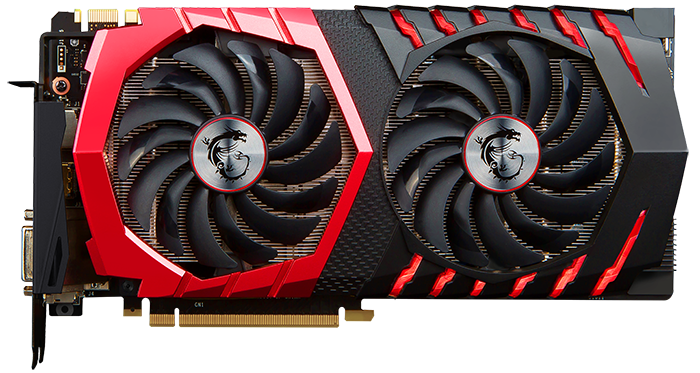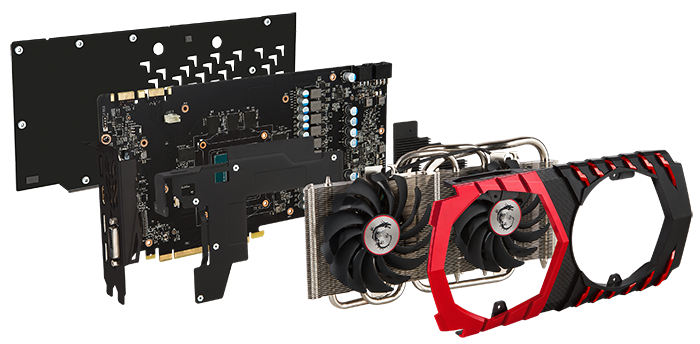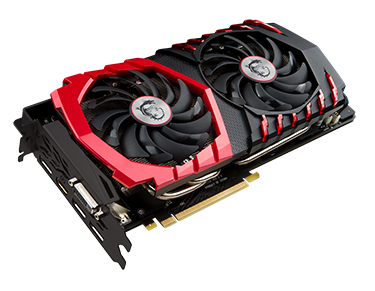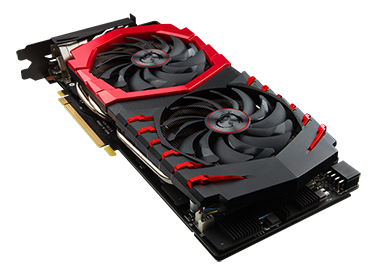Introduction
The race to produce the best premium graphics card is on. Competitors in said race need to be an Nvidia partner, for the GeForce GTX 1080, released last month, is the head honcho. We've already seen Asus and Inno3D have a go and offer something slightly different to each other. Now is the turn of dual-source partner MSI to show what it can do.
If you want variations on the GTX 1080 theme then MSI has you covered with no fewer than seven models using one of five heatsink designs. Choice, huh? Excluding the semi-watercooled Seahawk X for a moment, MSI's two most capable cooling systems are the Armor and Gaming X, with the latter having the combination of highest speeds and most customisation. MSI orders its line-up a certain way, so it would be rude not to take a look at the best air-cooled card in its arsenal.
And here is the Gaming X that's equipped with the Twin Frozr VI cooler first seen last year. MSI makes some bold claims about the efficiency of this new cooler, citing that at 30dB it keeps the GPU 20 per cent cooler - 60°C vs. 72°C - or 40 per cent quieter at the same 64°C temperature - 25dB vs. 40dB - than the last-gen model. Part of this improvement is down to the new Torx 2.0 fans that offer 13 per cent more airflow and 22 per cent more pressure than their immediate predecessors. A Torx 2.0 has two types of fan blades - normal and dispersion - which combine to offer these performance benefits, according to MSI.
All these lofty numbers shouldn't get in the way of noting that the card is aesthetically pleasing and very well built. Whereas competitors have gone with the big is better approach by using massively oversized coolers, the Gaming X is a picture of relative restraint. The card measures 279mm long, 140mm high (so bigger than normal) and stands 42mm tall, making it a dual-slot solution. Now-obligatory RGB LEDs are found lining the right-hand fan and on the nameplate situated on the side, and their colour and display pattern is controlled by additional an program contained within the APP suite. It all works well enough and is easy to use.
There are two Gaming-series cards - X and non-X - differentiated the the X variant carrying a backplate and an elevated core frequency. Speaking of which, the APP suite controls the specification of the card. As standard and out of the box, the Gaming X runs at 1,683MHz and 1,823MHz for base and boost, respectively. This can be changed to 1,708/1,847MHz in OC mode along with a 108MHz bump to the 10,000MHz GDDR5X memory, while dropping it down to Silent ensures the card runs at 1,607/1,733MHz, or at reference speeds. Our sample shipped with the correct default clocks.
The standard frequency is a tad low compared to the competition, it must be noted, but in-game performance is a touch better than expected due to our sample boosting to an average 1,911MHz during testing. As an aside, much like the front of the card, the rear heatsink is attractive.
MSI quotes the same 180W TDP as Nvidia but caters for overclocking by adding a six-pin connector for an extra 75W of juice. The company's Twin Frozr VI remains an open-air design where excess heat is recirculated into the chassis, so make sure you have good airflow.
An exploded view of the card shows how it all comes together. The heatsink uses flattened heatpipes that integrate into a solid nickel-plated copper base. There are specific heatsinks for the GDDR5X memory and the PWMs on the right-hand side, whose covering has a bunch of fins to maximise cooling provided by the twin fans above.
Though certainly not the largest PCB, the Gaming X's isn't reference. It uses 10-layer construction and has a 10-phase PWM design - reference has five - for better overclocking potential. That said, the initial batch of GTX 1080 GPUs haven't overclocked particularly well.
If you excuse the poor pun, we're fans of the zero-RPM mode adopted on most premium cards now. MSI's fans turn off when temperature drops below 60°C, meaning they remain off in most chassis - our card idled at 44°C and was therefore silent.
The Gaming X series would probably win the GTX 1080 beauty stakes. The IO section has the same solid matte-black look as the backplate. Outputs are standard for the GTX 1080, and for those that want to use the card as a base for VR shenanigans, MSI is set to release an optional kit that takes up a 5.25in bay but has HDMI and a couple of USB 3.1 connectors.
Gaming Series are backed by a three-year warranty and the package includes a one-year subscription to XSplit Premium, the streaming service, and a two-month license for WTFast, for purportedly lower-latency gaming.
MSI attaches a £630 recommended retail price to this Gaming X, putting it at the mid-to-high-end of AIC cards. Worth the money? Let the benchmarks ensue.
















